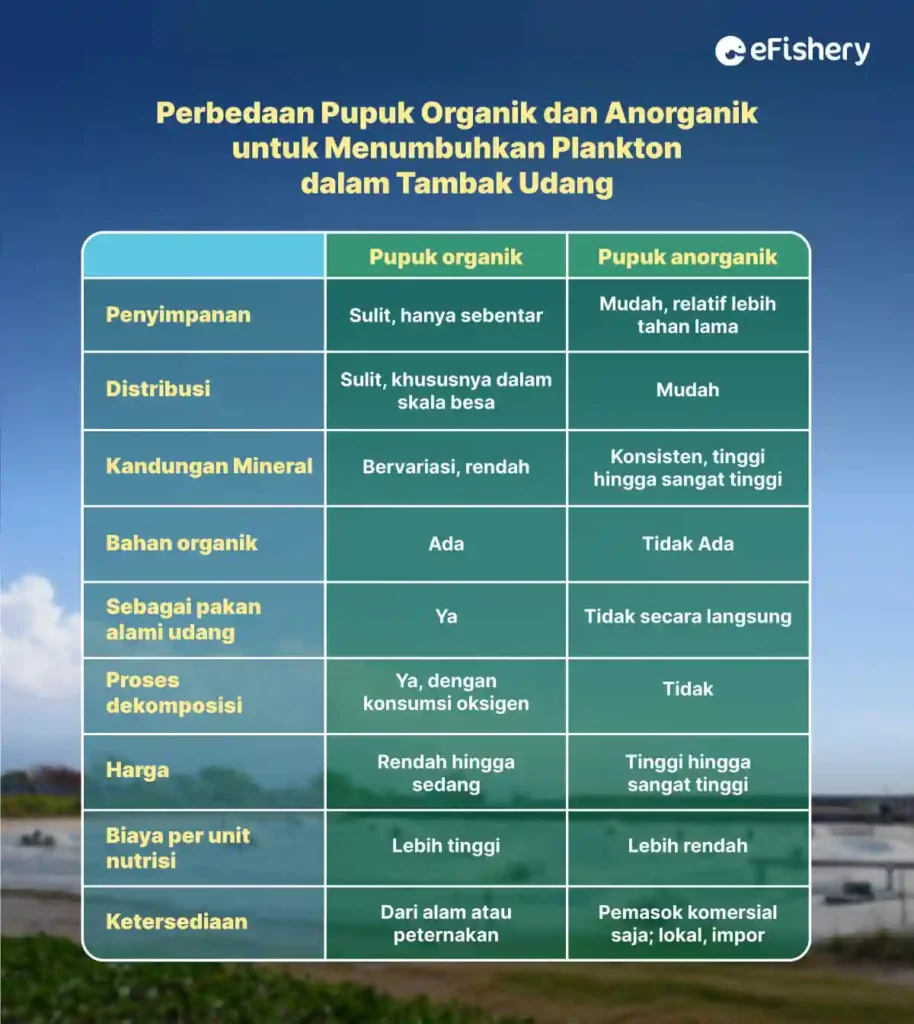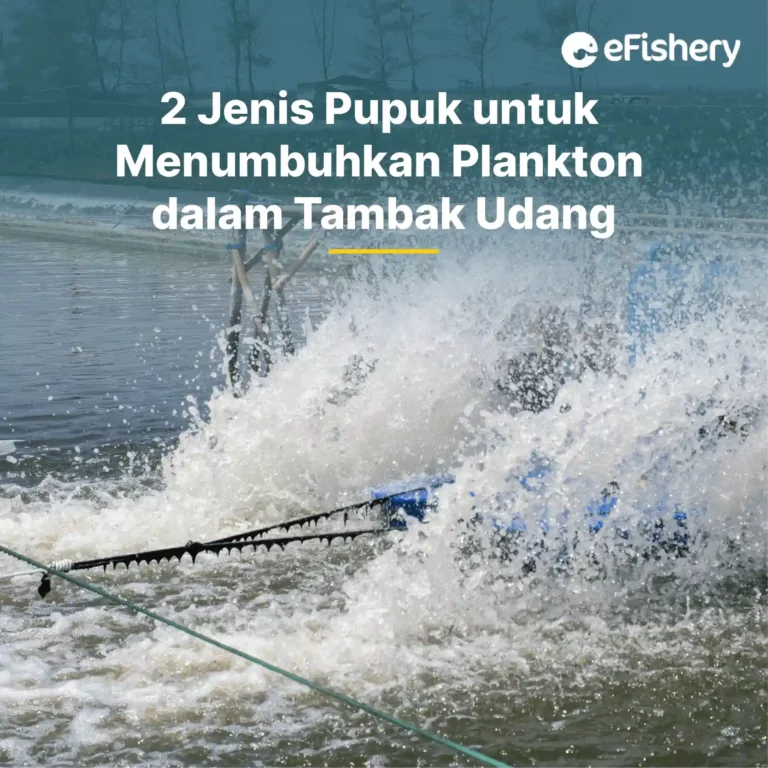Artikel Ini Telah Direview Oleh:

Nabilla Anggi
Magister Budidaya Perairan
Fertilizer is a material used by farmers to increase shrimp productivity. One of the functions of fertilizer is to encourage the development of plankton which is used as natural food for shrimp.
The following is a discussion of plankton and the type of fertilizer that is suitable for growing plankton in ponds.
Plankton as an Indicator of Water Quality
Water quality is a key factor in the success of shrimp farming. Decreasing water quality will cause stress and disease for the shrimp, and even cause crop failure. Controlled plankton can improve water quality and beneficial organisms (decomposing bacteria) for shrimp.
In addition, there are many benefits from the presence of plankton in pond waters, namely:
- Plankton makes the water conditions in the pond become shady, so that the shrimp can be more active in searching for food during the day.
- As a producer of dissolved oxygen in water. Plankton in ponds play a role in the process of photosynthesis, so they are able to produce oxygen during the day.
- As a natural feed for shrimp, because several types of plankton contain nutrients that shrimp can use to grow.
- Suppresses the growth of klekap and moss at the bottom of the pond. If plankton forms and forms shading on the pond, UV or light will be blocked from entering. That way, klekap and moss at the bottom of the pond cannot grow.
- Helps absorb chemical compounds such as ammonia, nitrites and nitrates. Plankton plays a role in the fixation stage, namely the process of converting dinitrogen gas into nitrogen. This process is utilized directly by plankton.
Fertilizer Types and Content To Grow Plankton
Fertilizers that can grow plankton consist of two different types of fertilizers, namely:
1. Mineral Fertilizer (Inorganic)
This fertilizer contains mineral nutrients that are useful in the growth of plankton and shrimp farming. This type of fertilizer does not contain organic matter and is similar to dolomite fertilizer used for shrimp farming. This fertilizer contains various nutrients, namely:
- Primary nutrients: nitrogen (N), phosphorus (P), and potassium (K)
- Secondary nutrients: eg calcium, magnesium, and sulfur
- trace nutrients: manganese, zinc, copper, and iron
2. Organic Fertilizer
This fertilizer is a mixture of organic matter and mineral nutrients. This fertilizer is usually produced locally, for example from livestock waste or agricultural waste. This fertilizer has enormous advantages for shrimp farming, namely:
- As a food source for plankton
- As a source of carbon dioxide needed by plankton in growth and development
- As an increase in the abundance of bacteria in the water to accelerate the decomposition of organic matter at the bottom of pond ponds

Fertilizer Application Method
The application of organic and inorganic fertilizers in shrimp ponds is usually carried out according to the nutritional needs of the shrimp in the pond. Organic fertilizers can be applied at the start of the growing season, when the shrimp in the ponds need a lot of nutrients to grow and develop. Meanwhile, inorganic fertilizers are usually applied to prevent nutritional deficiencies in the cultivation system, both macro and micro minerals.
Proper application of fertilizers can increase crop yields three to four times. In addition, the condition of the waters and shrimp is getting better. To get these results, use fertilizers that can stimulate the growth of plankton.
Here's how to apply fertilizer to ponds:
- Ithe pool with clean water that is free of iron and manganese levels and is sterile from disease outbreaks.
- Fill the pond with 30-40 cm of water, depending on the container used.
- Give urea fertilizer 8 gr/m3 and dolomitic lime 200 gr/m3. Spread in ponds in the morning after the sun starts to rise.
- Next, give probiotics as much as 10 gr/m3 evenly in ponds.
- Sprinkle dolomite lime and urea fertilizer regularly for 3-5 days in a row until you get bright green water.
- When the color of the pond water is bright green, the shrimp seeds are ready to be sown according to stocking density.
Get Fast Growing Plankton Solutions Through the eFarm Cultivation Consultation Feature!
Need Help Regarding Shrimp Cultivation Business?
Fill in your personal data in the following form. Our team will immediately contact you via the number cellphone attached. Make sure the data entered is correct.
The use of organic and inorganic fertilizers will complement each other in growing plankton. In general, fertilizing ponds using organic and inorganic fertilizers depends on soil conditions, soil fertility, cultivation technology level, and stocking season.
If you are still confused and need assistance in fertilizing shrimp ponds, you can consult for free in the features Cultivation Consultation from eFarm. Now!
eFarm is a shrimp farming application that provides various solutions to your shrimp farming problems. One of which is Cultivation Consultation, where you can chat directly with a team of shrimp farming experts from eFishery to get the most appropriate pond treatment steps.
Interested in consulting shrimp farming for free? Come on, consult the problem of shrimp farming through eFarm

Nabilla Anggi - Magister Budidaya Perairan
Nabilla merupakan lulusan sarjana dan magister budidaya perairan serta memiliki pengalaman di dunia perikanan baik hatchery maupun pembesaran
Questions Regarding Fertilizer for Growing Shrimp Pond Plankton
There are two types of fertilizers that can support the growth of plankton, namely organic fertilizers and inorganic fertilizers. The use of these two types of fertilizer will complement each other in the process of growing plankton.
The benefits of plankton in shrimp pond waters, namely making the water conditions shady, as a producer of dissolved oxygen in the water, as a natural feed for shrimp, suppressing the growth of klekap and moss at the bottom of the pond, and can help absorb chemical compounds such as ammonia, nitrite and nitrate.
- Andarias, I. 1991. Effect of Urea Fertilizer and TSP on Kelekap Production. Dissertation. Postgraduate Faculty, Bogor Agricultural Institute. Bogor, 155 pp.
- Atmomarsono, M., Muliani, Nurbaya, Susianingsih, E., Nurhidayah, & Rachmansyah. 2013. Increase in Tiger Shrimp Production in Plus Traditional Ponds with the Application of RICA Probiotics. Marine and Fisheries Technology Recommendation Book 2013. Marine and Fisheries Research and Development Agency. KKP. Jakarta, p. 33-43.
- Aziz, R., Nirmala, K., Affandi, R. & Prihadi, T. 2015. Plankton Abundance Causes Mud Smell in Milkfish Cultivation Using Different N : P Fertilizers. Journal of Indonesian Aquaculture, 14(1), 58-68.
- [FAO] Food and Agriculture Organization. 2017. Fertilizing Fish Ponds.
- Poernomo, A. 1988. Making Shrimp Ponds in Indonesia. Development Series No. 7, 1988. Ministry of Agriculture. Agricultural Research and Development Agency. Coastal Aquaculture Research Institute, Maros. 30 p.m.
